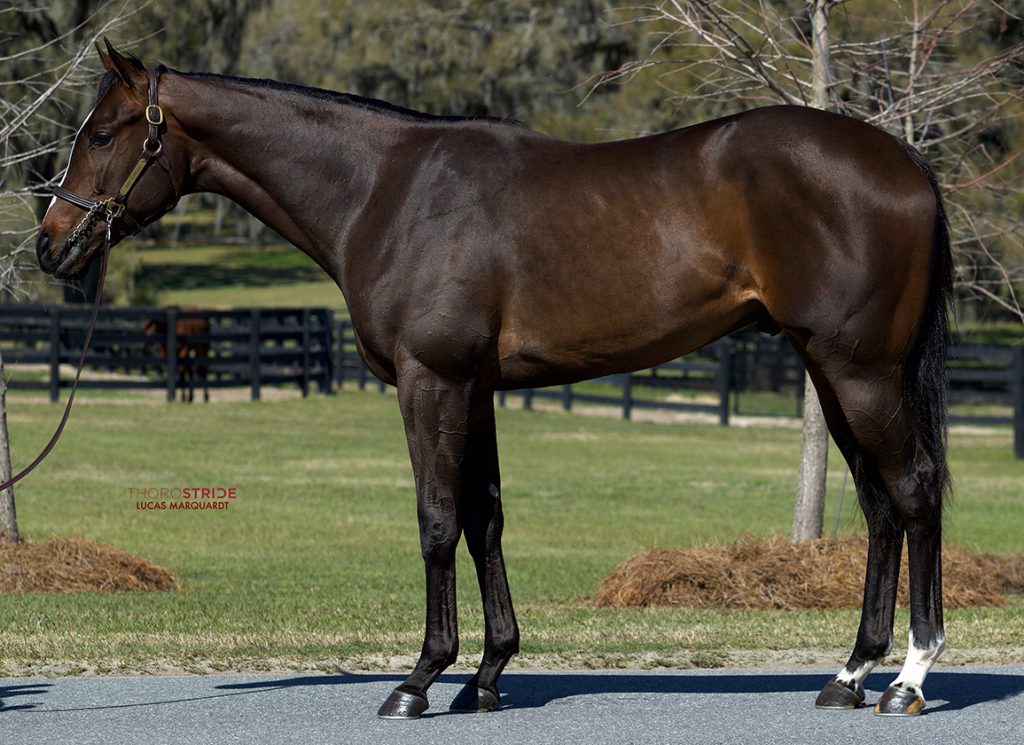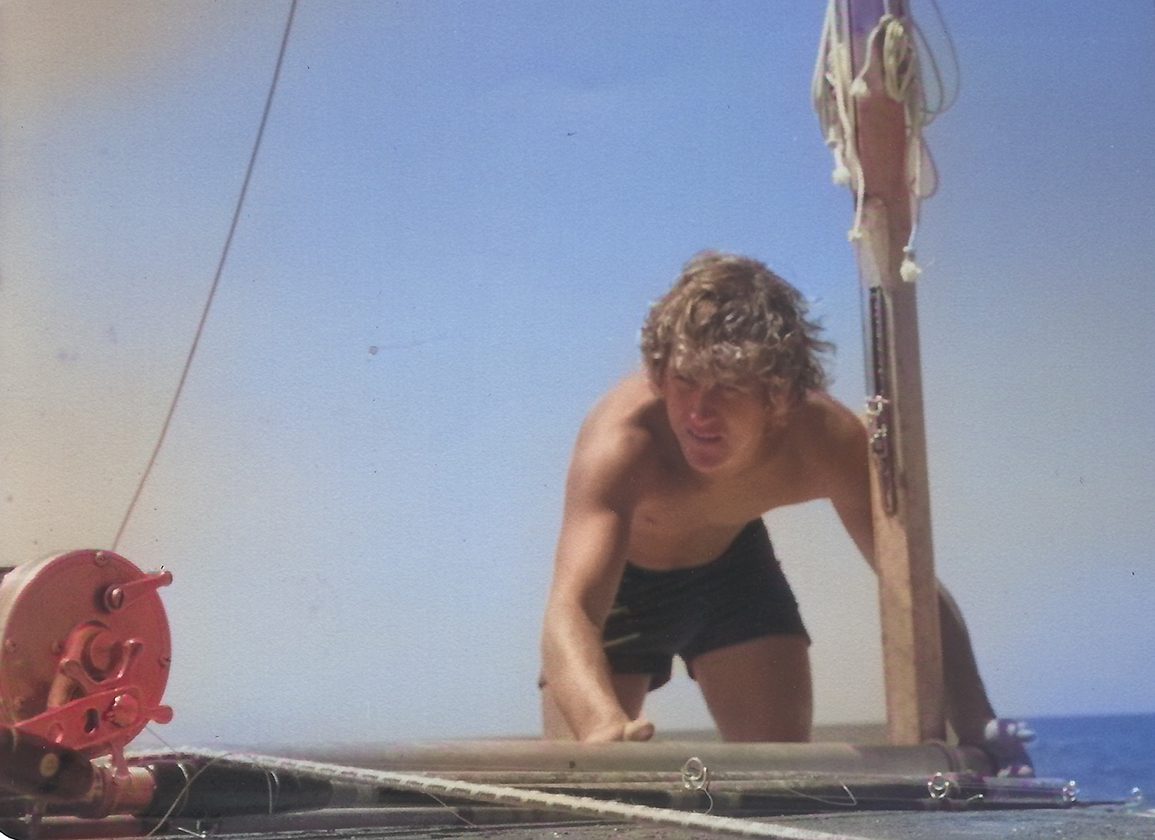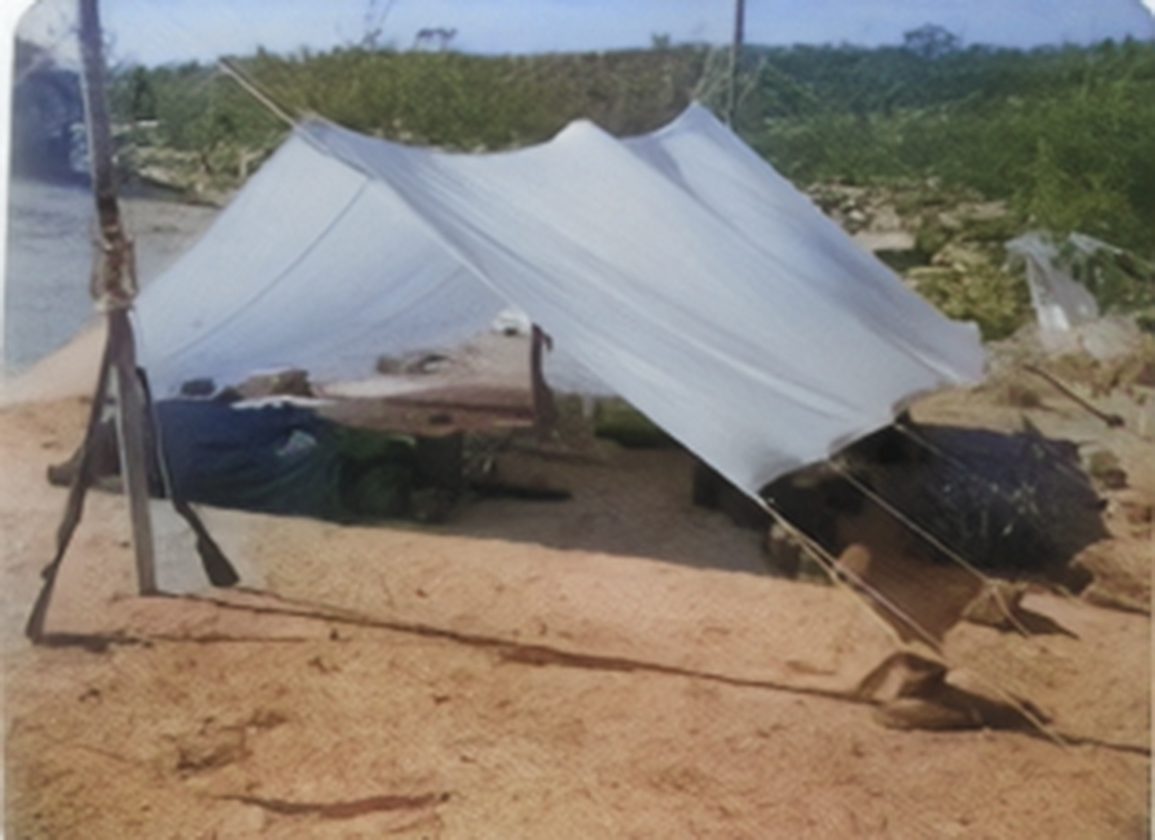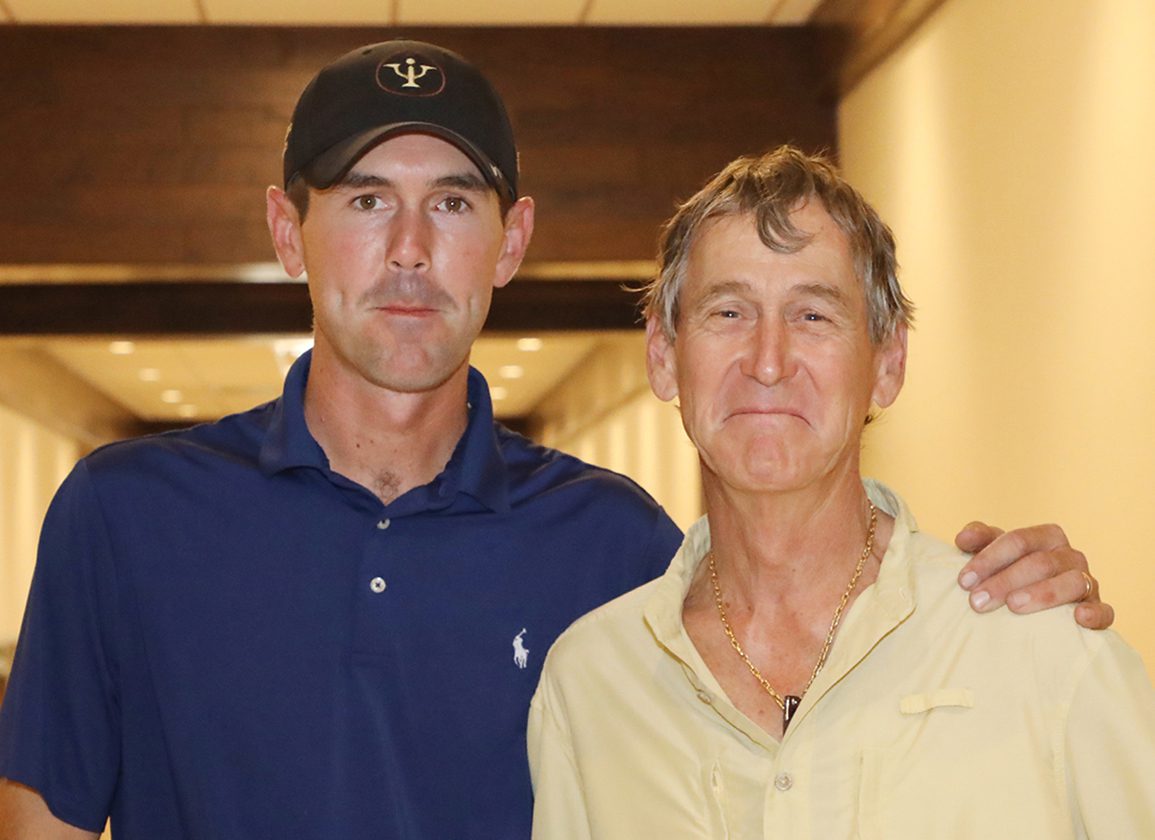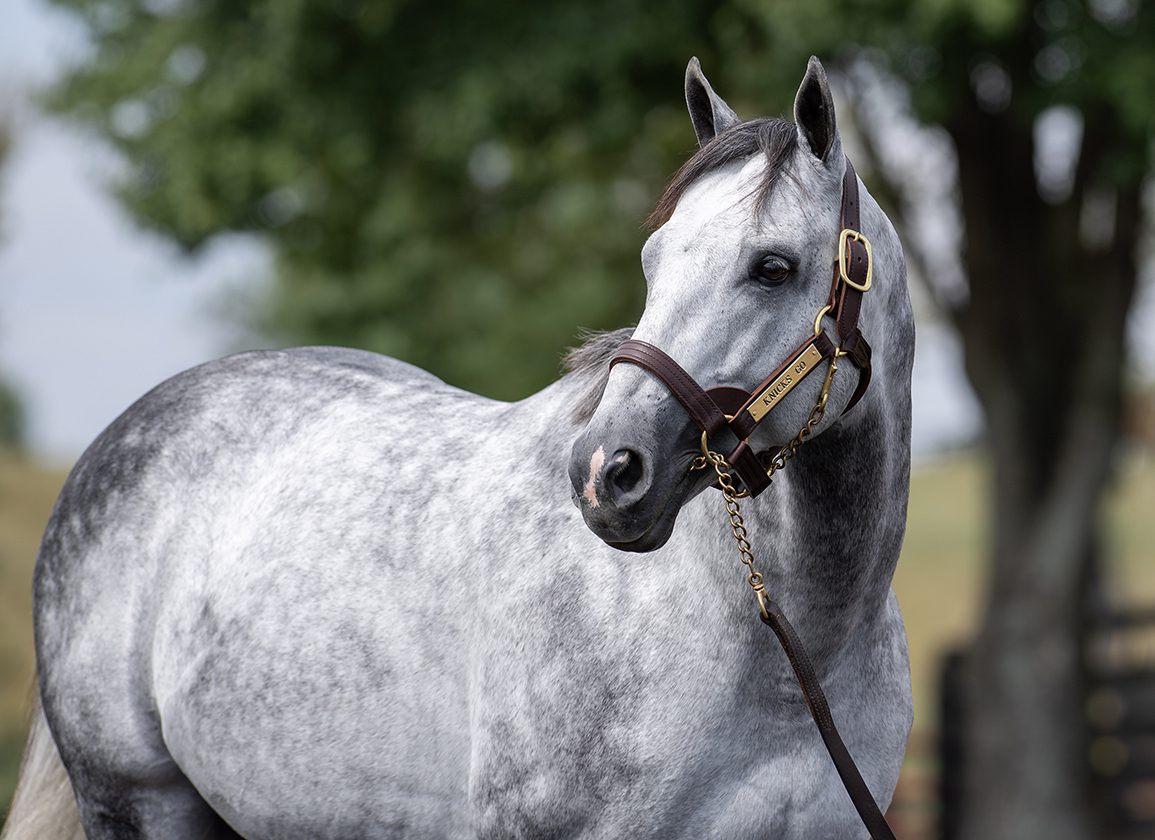by Jessica Martini & Christina Bossinakis
OCALA, FL – With a pair of colts topping the seven-figure mark, the tempo picked up during the second session of the Ocala Breeders' Sales Company's March Sale of 2-Year-Olds in Training Wednesday. With 144 horses sold Wednesday for $25,488,000, the session average was $177,000–up 6.2% from last year's corresponding session–and the median of $87,500 declined 2.8% from a year ago. The buy-back rate was 31.8%.
“I thought it was a very good session,” said OBS Director of Sales Tod Wojciechowski. “It felt like there was activity all through the day at all levels. The numbers bear that out. It felt really good today.”
Through the first two days of the three-day auction, 307 horses have grossed $47,164,000. The average of $153,629 is down 2.2% from last year's corresponding figure and the median is down 11.8% to $75,000. The cumulative buy-back at the end of Wednesday's session was 26.7%. It was 27.3% at the close of the second session last year.
Trainer Jose D'Angelo made the highest bid of Wednesday's session when going to $1.5 million to acquire a colt by Not This Time. Earlier in the session, Ramiro Restrepo of Marquee Bloodstock went to $1.3 million to acquire a colt by Flatter. With that colt to be trained by Gustavo Delgado, both million-dollar juveniles will be kept in training with Florida-based trainers.
“It's exciting for the future of Florida racing,” Wojciechowski said.
With one session still to come, this year's OBS March sale has now produced three seven-figure juveniles. The entire 2023 sale had five 2-year-olds reach that threshold.
A total of 23 horses have sold for $500,000 or more through two sessions, compared to 14 to reach that level at the same point last year.
The OBS March sale concludes with a final session Thursday beginning at 11 a.m.
D'Angelo Looking for More Time
Jose D'Angelo, who has a colt on the GI Kentucky Derby trail with Morplay Racing's No More Time (Not This Time), was already looking ahead to next year's Triple Crown chase when he purchased another colt by Not This time for $1.5 million in Ocala Wednesday. D'Angelo said he purchased the colt for a partnership of owners, which includes Morplay's Rich Mendez. Mendez had partnered with Randy Hartley and Dean DeRenzo to purchase the colt for $900,000 at last year's Fasig-Tipton Saratoga sale.
“I train No More Time, so we were looking at another son of Not This Time,” D'Angelo said after signing the ticket on hip 533 in the name of Pro Racing Stable. “He had an amazing work with a nice gallop out. And he looked mentally very focused. We are on the way to the Derby with No More Time. And I spoke with all of the owners and I told them this was a good opportunity to get a good horse for racing next year. Rich Mendez owns No More Time and I train horses for him. So hopefully we can replay this story next year with another son of Not This Time.”
Consigned by Hartley/DeRenzo Thoroughbreds, the colt is out of Pammy Whammy (War Front) and is a half-brother to stakes-placed Pammy's Ready (More Than Ready). He worked a furlong last week in :9 4/5.
Mendez was standing next to Randy Hartley and Dean DeRenzo when the pinhookers acquired the colt at last year's Saratoga sale.
“We paid a lot of money for him at the yearling sale,” Hartley said. “We thought he was a beautiful horse at Saratoga. We took a shot and brought him here and he worked beautiful. It is bittersweet because we loved the colt so much. We wanted to hang on, but we're here to sell horses.”
Of the colt's final price, Hartley said, “The sale has been all or nothing, so we figured it was going to be really big or nothing. Jose got the colt and we are so proud of him because he also trains some for us, too. He has our horse [No More Time] that we're headed to the Derby with, too. There are a bunch of his people that just love Not This Time, so they made a deal together. We hope they can be successful.”
A native of Venezuela, D'Angelo has been training in the U.S. for five years now. He works alongside his father, who was a champion trainer in their native country.
“I arrived in the U.S. in 2019 and in 2020, I got Jesus' Dream, who brought me to the Breeders' Cup and the Preakness S. and Dubai World Cup and Pegasus World Cup. He put me on the map.”
D'Angelo hopes No More Time will help continue his career's upward trajectory. The sophomore won the GIII Sam F. Davis S. in February and was second last week in the GIII Lambholm South Tampa Bay Derby.
“This is the first year with my babies,” he said. “I am very happy and I feel blessed. Probably next year we will have better babies.”
As for plans for his newest Not This Time colt, D'Angelo said, “We will let him decompress for 15 days on the farm and later we will send him to Palm Meadows where I am getting all my babies. We will prep him for Keeneland or Saratoga. We don't know how early he can go, we are just going to do whatever is best for him and see what happens.” @JessMartiniTDN
Flatter Colt Lights Up OBS
A colt by Flatter (hip 494) became the second seven-figure juvenile of the March sale when bringing a final bid of $1.3 million from bloodstock agent Ramiro Restrepo. Restrepo, who signed for the colt in the name of his Marquee Bloodstock, said he had purchased the colt on behalf of a group of international partners, including Gustavo Delgado, who will train the youngster. Delgado has already had success with offspring of Flatter. The stallion is the sire of Paola Queen, who won the 2016 GI Test S. for the trainer.
The dark bay colt, who worked a furlong in :9 4/5 during last week's under-tack show, is out of Napier (Midnight Lute), a half-sister to Grade I winner Obligatory (Curlin). He was consigned by Sequel Bloodstock on behalf of his breeder, Gentry Stable.
“The family, with the dam being a half-sister to Obligatory, it's four generations of Juddmonte,” Restrepo said. “You have to respect that type of breeding program. So this is a horse that, if he goes on to do what you buy these kind of horses to do, eventually he will be a sire. He has that kind of female family supporting him.”
Delgado and his son and assistant Gustavo, Jr., as well as Restrepo hit the big stage with a partnership which tasted victory with Mage in last year's GI Kentucky Derby.
The younger Delgado has plenty of optimism for this newest acquisition.
“Gustavo Delgado, Jr. was with me at the sale and he loved the horse so much and was crucial in getting this done,” Restrepo said.
Of the partnership, Restrepo added, “The group is going to be comprised of several partners, both domestic and international. I was just in the Middle East for the G1 Saudi Cup and Super Saturday [at Meydan] and met with some interesting clients over there. So this will be another interesting hodge-podge mix of characters into this gumbo and we are always open to bringing other partners into this group. It's never one locked-up team. With are using a the-more-the-merrier approach. We will race together and hopefully celebrate together.” @JessMartiniTDN
Chasanoff's Audible Pays Off
Robert Chasanoff of Gentry Stable typically sells his foals as yearlings, but the breeder decided to hold back a Flatter colt last year and the decision paid dividends Wednesday in Ocala when the juvenile, consigned by Becky Thomas's Sequel Bloodstock, sold for $1.3 million to Ramiro Restrepo's Marquee Bloodstock.
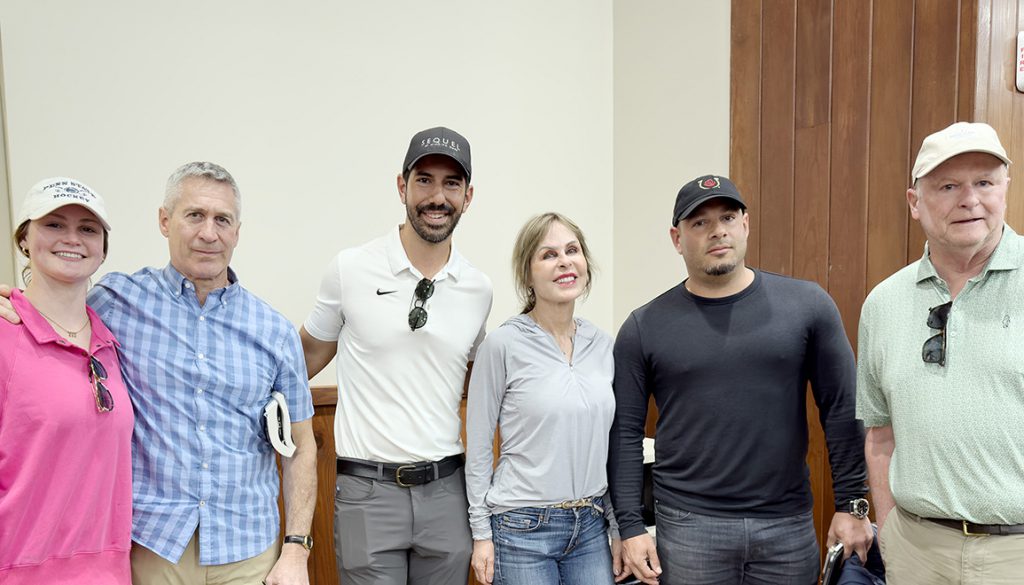
Robert Chasanoff with daughter, Carlos Manresa, Becky Thomas, Ramiro Restrepo, and Tom Bozarth | Photos by Z
“Becky has been raving about the horse in her own low key way,” Chasanoff said after watching the colt go through the ring. “Obviously, the horse has done really well. He worked so well and we had just positive feedback. I thought he would sell well, but he exceeded my expectations. But he has exceeded my expectations every step of the way since he's been a foal.”
The colt is out of Napier (Midnight Lute), a half-sister to Grade I winner Obligatory (Curlin). The mare was purchased by Chasanoff's bloodstock advisor Tom Bozarth for $130,000 at the 2018 Keeneland November sale.
“I only have three broodmares and I typically sell my yearlings,” Chasanoff said. “We liked this horse enough to keep him back. He was a little immature and I didn't think we would get full value. I thought, well I haven't trained one in a while, maybe I will send him to Becky and we will train him or race him. The next thing I knew, he was in the sale.”
Chasanoff looked at Thomas and said with a laugh, “She thought he was too good for me.”
Chasanoff gave credit for Wednesday's success to the entire team surrounding the colt.
“Tom Bozarth is responsible for all my matings and he has been for 25 years,” he said. “All of my success is thanks to Tom. The colt was raised by Mike Owens at Cobra Farm, and of course Becky. Becky took him from being just a nice horse to that. It was all Carlos [Manresa] and Becky and the team at Sequel. I couldn't say enough about them.”
Napier, who RNA'd for $285,000 at the 2022 Keeneland November sale, has a yearling colt by Maxfield and was bred back Wednesday as her 2-year-old prepared to go through the sales ring in Ocala.
“She is being bred today to Elite Power,” Chasanoff said.
Of the sale result, he added, “I am gratified beyond all reasonable expectation. When you do business with Tom Bozarth or Becky and Carlos, good things will happen. That will be the best comment I could make.” @JessMartiniTDN
Nyquist Filly to Casse, Eventually
A filly by Nyquist (hip 304) jumped to the lead early in the second session of the OBS March sale Wednesday when selling to bloodstock agent Justin Casse, bidding on behalf of an undisclosed client, for $750,000. Consigned by Wavertree Stables, the juvenile is out of High Heeled Girl (Malibu Moon), a daughter of Grade I placed High Heeled Hope (Salt Lake) and a half-sister to graded winners Lady T N T (Justin Phillip) and Sweet Hope (Lemon Drop Kid).
“I love the sire,” Casse said of the filly's appeal. “And I think she was a beautiful physical. She'd catch your eye just walking by. She was just that type. And then what she did on the track was very special as well. She put in a very good time and she's an excellent mover and she did it right.”
The filly worked a furlong in :9 4/5 at last week's under-tack preview.
“I don't know which trainer she is going to,” Casse said. “She doesn't seem like the type that needs any time. She could probably go right on. She looks like a promising 2-year-old type. But as of this moment, there are no plans.”
The chestnut filly was originally led out of the ring at $850,000, but after some confusion and much discussion, she was ultimately sold for $750,000.
“I am not entirely sure what happened,” Casse said. “It looked like basically a bid might have been taken that was supposed to be lower than what they were put in at–it looked like somebody was put in at $800,000 and they were trying to be $775,000. I think there was a bit of that. That was my take, from what I could tell. We are very happy to have the horse at the end of the day at that number after the dust had settled.”
Also unsure how the kerfuffle had occurred, Wavertree's Ciaran Dunne said, “I haven't had time to go and talk to OBS and see what actually did happen. Unfortunately, you have to make game time decisions and we couldn't sit around, we had to make a decision and we made the decision to go ahead and sell her. We probably would have been very happy without the shenanigans and when the check arrives, we will probably forget about the shenanigans and be happy again.”
The filly was purchased by the Red Wings pinhooking partnership of Paul Reddam, who campaigned her GI Kentucky Derby-winning sire, and Dunne for $250,000 at last year's Keeneland September sale.
“She's by a stallion, for us, that is probably one of the top stallions in the country,” Dunne said. “I think he's an amazing stallion–dirt, long, short, it doesn't matter. They are horses that are great to train. We have been fortunate to be around enough of them because to our connection with Mr. Reddam. So he's always a stallion who is high on the radar for us. Physically, I thought she was as good a filly as you're going to get. Great shape, great hind end on her, moved good, and she did everything we wanted her to do on the racetrack.”
Later in the session, Wavertree sold a colt from the first crop of graded stakes winner Shancelot (hip 421) for $650,000 to Bill Childs. The juvenile, who worked a furlong last week in :9 4/5, was purchased by Dunne's Waves Bloodstock partnership for $130,000 at Keeneland last September.
“He brought all a Shancelot was ever going to bring,” Dunne said. “He was a beautiful colt when we bought him, so it wasn't rocket science. He matured just as you would want him to and he performed on the racetrack. I think he brought as much as a first-season stallion people probably forgotten was at stud could bring.”
The speedy Shancelot won the 2019 GII Amsterdam S. and was second in that year's GI Breeders' Cup Sprint, but questions surrounded him as he began his stud career when his trainer Jorge Navarro was sentenced to five years in prison for employing performance-enhancing drugs.
Asked if there were any concerns about buying a six-figure yearling by the stallion last fall, Dunne said, “Maybe I am naive, but we've been doing this a long time and I'm not sure that anybody has ever come up with anything that can make one go faster than it is. I remember seeing that horse win at Saratoga and I was blown away.” @JessMartiniTDN
One and Done for Speedway
Peter and Ann Fluor and Kane Weiner's Speedway Stables don't depend on numbers when attending the season's biggest sales. But what they lack in quantity they more than make up for in quality, and employed that formula again Wednesday when landing Hip 445, a colt by Mitole, for $725,000. Peter Fluor handled the bidding duties for the dark bay, who was the sole purchase for the team through the first two days of the sale.
“It was a little beyond where we had hoped he'd be. We are aware of the fact it is usually all or nothing,” admitted agent Marette Farrell. “We didn't want to pay any more, but we are happy to get the horses. We had to stretch a little bit, but we were at the tipping point.”
Consigned by Eddie Woods, the son of Midnight Magic (Midnight Lute) breezed :9.4 during Friday's breeze session. The Florida-bred colt is a half-brother to GIII Delaware Oaks winner Midnight Stroll (Not This Time) and stakes-placed Atthecrossroads (Practical Joke). Midnight Magic is a half-sister to Grade III winner Coalport (Kitten's Joy), in addition to French listed winner Jolly Good Kitten (Kitten's Joy).
“He had a flawless breeze and we just loved his gallop out,” recalled Farrell. “An obvious selling point was that he was by Mitole, who was the champion first-season sire last year. However, what we really liked about this particular colt was the way he was built. He had more Midnight Lute in him, more stretch and more length. [Trainer] John and Tonya Terranova train [GSW Midnight Stroll], so we were aware of that.”
According to Farrell, the $250,000 OBS October purchase will ultimately head to Bob Baffert.
“We hope he will be a Del Mar horse,” she said.
In addition to the obvious talent witnessed on the track last week, Farrell also pointed to some of the more intangible factors that went into pursuing the colt.
“It was the class of the horse. We went back after we bought him and there he was, head out of the stall eating hay and very calm. I love that too,” explained Farrell. “Angela [Woods] told us he's a highly intelligent horse and every day when they clean his stall, he's back on the clean part of the shavings laying down. To me, growing up in Ireland, that was something that was really important. The really good horses really take care of themselves and are easy on themselves mentally.”
She continued, “When they go to the next level, it's stress 24/7. They go into a tense environment every morning. So if they can zone out and chill, I think they are easy on themselves mentally and physically as a result.”
From limited 2-year-old purchases over the past few years, Speedway has unearthed a handful of gold nuggets at OBS, most notably GI Pacific Classic scorer Collected (City Zip), a $170,000 OBS March buy in 2015, and juvenile champion Corniche (Quality Road), secured for $1.5 million at the OBS Spring sale in 2021. Both colts were trained by Baffert for the majority of their careers.
“I feel really comfortable at the 2-year-old sales,” she said. “We have a great team here. At the yearling sales, sometimes it feels like 'pin the tail on the donkey'. You just don't have as much information to go by. But at the juvenile sales, there are a lot more factors to consider. And I really find that fun.”–@CBossTDN
Strong Showing for Woods at OBS
Eddie Woods usually can be counted on to come well armed to the OBS sales and this season was no different. Highlighting his consignment on the second day of the sale, the Woods team was headed by Hip 445, a colt by Mitole who realized a $725,000 final bid from Speedway Stables. Woods purchased the colt for a sale topping $250,000 at OBS last October. Also during Day 2 of the sale, Woods sold Hip 499, a filly by Twirling Candy, for $600,000 and Hip 348, a Florida-bred colt by the Lane's End sire for $550,000. Rounding out his top sales of the session was Hip 395, a $400,000 colt by freshman sire Improbable.
From 10 horses offered Wednesday, Woods got nine of the sold, with eight realizing over $200,000.
“I thought he'd sell really well, but I didn't really think he'd bring over $700,000,” admitted Woods on the sale of his session topper. “We paid well for him in the beginning because he was a really good-looking yearling. He just kept getting better all winter. He stayed together and vetted well. He worked fantastic even though he worked on his wrong lead, which was a surprise because he's never put a foot wrong. But that's the way it goes. He's magnificent looking and I think he has a chance to be a really top-end horse.”
Weighing in the colt's dam, Midnight Magic (Midnight Lute), Woods added, “He's out of a good mare. I tried to buy the sister [GSW Midnight Stroll] a couple of years ago, but Tonya Terranova outbid me for her and she went on to become a graded stakes horse for them. And these horses were similar. The Midnight Lute is a big influence on that whole family.”
At this venue last year, the Woods consignment was headed by the Twirling Candy colt Top Conor, who brought $1-million from Sean Flanagan. The colt, who was the co-fourth highest priced at this venue last season, broke his maiden for Chad Brown at Gulfstream Park Feb. 17 and is targeting the GII Wood Memorial at Aqueduct Apr. 6.
Asked about his apparent affinity with the sire, Woods explained, “I've been lucky with Twirling Candy. We also had a beautiful-looking horse sell here for $550,000 here today. I actually thought he would bring a little bit more because Twirling Candy is a bit more accomplished [than Mitole] at this point. We also had a filly bring $600,000 and she was just an athlete. She was an oil painting. She did just everything right.”
However, even with the stars aligning and all the pieces falling exactly into place, Woods was quick to point out the common theme in the juvenile sales market.
“If they are good they'll give you all you need from them, but if they're not, you'll be holding on to your hat.” —@CBossTDN
The post $1.5-Million Not This Time Colt on Top as Action Ticks up at OBS March appeared first on TDN | Thoroughbred Daily News | Horse Racing News, Results and Video | Thoroughbred Breeding and Auctions.


